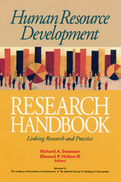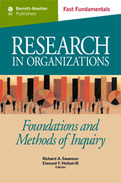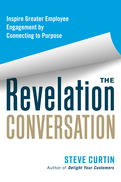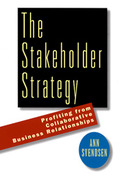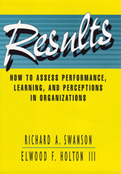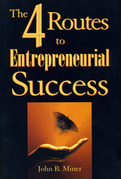How is it that some Human Resource Development (HRD) professionals consistently get the results that their organizations need, while others regularly get lost in the process? The Human Resource Development Research Handbook argues that expert HRD professionals think like researchers. You don't need to be a researcher to obtain consistently high-quality HRD results, but thinking like a researcher gives you the discipline required to be an expert. Thus, the much-hyped gap between theory and practice is the arena of opportunity and excellence. The Human Resource Development Research Handbook gives practitioners the tools they need to stay on the leading edge of the profession. It addresses three core areas: The practical importance of research; ways of doing practical research; and getting started on research. Written for practitioners and scholars, this is the first book to explain the value, purposes, methods, and processes of HRD research in clear, simple language.
The Human Resource Development Research Handbook demystifies the research process so HRD practitioners can transform their practice to incorporate leading-edge research. Each chapter is written in straightforward language by a leading researcher. Real-world examples clearly show how research and theory are not just for academics, but are practical tools to solve everyday problems.
- Written by top researchers in the field of Human Resource Development
- Uses real-world examples to make the research understandable
- Helps practitioners solve complex practical problems that need the application of existing or new research
- Sponsored by the Academy of Human Resource Development and the American Society for Training and Development
Nearly every organization has a mission, vision, or purpose statement that is displayed on its website or framed and mounted in the executive corridor. But it is largely unknown to employees and seemingly unrelated to their daily jobs.
As a result, while employees may possess the knowledge and skills to do their jobs, they are unaware of what bestselling customer service author Steve Curtin calls job purpose: how their specific tasks contribute to the organization's reason for being. They understand what to do and how to do it, but not why they do it.
Curtin offers a fresh tool to overcome this challenge. The Revelation Conversation is a one-on-one exchange where leaders and managers involve employees in the discovery of their total job role, connect job duties to job purpose, and inspire greater employee engagement. Instead of just having assignments to work on, they now have a purpose to work toward. Service quality goes from transactional to exceptional.
The book contains dozens of examples of how leading companies link their corporate ideals to employees' daily job responsibilities. By creating an environment for employees to do work that matters rather than simply check boxes and go through the motions, employers will reap the benefits of higher levels of employee engagement, productivity, and customer satisfaction.
- Provides an integrated framework for understanding a corporations responsibilities to a broad array of stakeholders-from customers to suppliers, employees, and communities.
- Offers a step-by-step guide as well as practical strategies that companies can use to forge a network of powerful and profitable collaborative
- stakeholder relationships.
- Features case study examples of companies across North America and Europe that are building collaborative relationships with their stakeholders.
1999
This book presents a practical guide to building a successful, competitive, and cost-effective HRD practice that meets customers' needs. Results teaches readers a highly effective, easy-to-learn, field tested system for assessing organizational results within three domains: performance (system and financial), learning (knowledge and expertise), and perceptions (participant and stakeholder).
Why measure results in HRD? Because the "corporate school" and "human relations" models of HRD practice, whereby development occurs simply because it is good for employees, no longer works. If HRD is to be a core organizational process, it must act like one and hold itself accountable. Measuring results, particularly bottom-line performance results, is key to gaining support from top management. And those who measure results ultimately find it a source of program improvement and innovation as well as pride and satisfaction.
While Results is theoretically sound, it is firmly rooted in practice, offering a core five-step assessment process that gives readers a simple and direct journey from analysis inputs to decision outputs. Whether they have assessment tools but no theory, theory but no tools, or no tools and no theory, this book will equip them to quickly and effectively assess their results.
- Shows human resource development (HRD) professionals how to measure organizational results within the domains of performance, learning, and perceptions using the effective and efficient Results Assessment System
- This widely praised system simplifies the complex issues of assessment, enabling HRD professionals to clearly demonstrate their results
- Real-life examples illustrate how the principles work
- From the author of Analysis for Improving Performance , winner of the 1995 Outstanding Instructional Communication Award from the International Society for Performance Improvement and the 1995 Society for Human Resource Management Book Award
It is a common belief that there is an entrepreneurial personality-that a certain type of person is capable of becoming a successful entrepreneur, while others are not. Research supports this view, and yet there are countless stories of people who have failed in one entrepreneurial venture only to succeed in another, and still others who have achieved initial success, yet failed when their company reached a certain size.
John B. Miner, an expert in the fields of entrepreneurship, human resource management, and personality psychology, has spent 20 years researching these and other curiosities about entrepreneurial success. In this groundbreaking book, he details his extensive research that shows that there is not a single entrepreneurial personality type, but rather, there are four distinct personality types that make for successful entrepreneurs.
Based on 20 years of research and a systematic seven-year study of 100 entrepreneurs, The 4 Routes to Entrepreneurial Success details the distinctive characteristics of each of the four types and explains why they succeed or fail. Using Miner's self-assessment questionnaire, you'll discover whether you possess the talents, skills, and characteristics it takes to start and run your own business. The results of the questionnaire will help you determine how you can be successful as an entrepreneur.
The different routes by which each of the four types achieves success are explored in detail, and numerous real-life examples of established entrepreneurs are included throughout. If you're a would-be entrepreneur, this accessible, easy-to-read, and practical book can help you achieve the success you dream of.
Miner explains that, to be successful, entrepreneurs must concentrate on their special talents and strengths, while finding ways to compensate for their weaknesses to accomplish the rest of the business process. For instance, while Supersalespeople are experts at bringing in new customers, they often lack the necessary management skills to run a successful business, and therefore need someone else to oversee the operations. Expert Idea Generators are good at creating new ideas, but need others to develop effective systems to get them to market. The characteristics of each type of entrepreneur are explored in detail, as well as the routes by which each achieves success, and numerous real-life illustrative case studies of established entrepreneurs are included throughout. Most importantly, Miner provides individuals with practical guidelines for mapping out their own routes to success.
The 4 Routes to Entrepreneurial Success can help you assess not only whether your personality is suited to the entrepreneurial lifestyle, but also what type of venture you should consider and what role you should play in your business to guarantee success. In addition to outlining each type's inherently appropriate career route, Miner insightfully addresses gender differences, the value of entrepreneurial development and formal degree programs, and entrepreneurial options for those who do not fit into any of the types described.
The 4 Routes to Entrepreneurial Success will help prospective entrepreneurs assess their own talents and determine what type of venture offers them the greatest chances for success. Established entrepreneurs will gain new perspective on current problems and learn to foresee and avoid potential pitfalls. Senior managers and human resource managers will find valuable tools for staffing corporate ventures, while bankers, venture capitalists, and other investors can better assess the risk and return related to their investment.
- Groundbreaking research reveals the four personality types of successful entrepreneurs and shows how everyone can learn from their winning ways
- An accessible, easy-to-read, and practical book that can help would-be entrepreneurs achieve the success they dream of
- Offers numerous real-life examples of successful entrepreneurs
- Includes a questionnaire to help readers determine what type of entrepreneur they are


